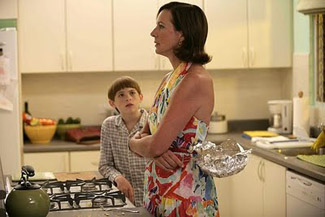Chapter Two: Life During Wartime
By Brett Ballard-Beach
August 16, 2012
Many of the actors and actresses in the film, at that time, were better known for their television performances than big-screen careers (Lara Flynn Boyle, Camryn Manheim, Cynthia Stevenson, Jon Lovitz) and Solondz seems to have selected them precisely for being known in that context or for eliciting murmurs of “Where do I know him/her from?” Stevenson in particular does a gloss on the eternally perky sitcom wife and mom of yore, who in this case barely conceals over her fear and frustration of what she suspects has become a sham marriage. This sitcom attitude is mirrored in the technical aspects. The production design by Therese DePrez and art/set direction by John Bruce and Nick Evans establishes a plastic world of mostly interior sets where cubicles and closed apartment doors foster anonymity and perfect suburban houses hide secrets. Maryse Alberti’s cinematography complements this with bright (but not harsh) lighting and framing that highlights the flatness of these people’s world. It is perhaps no wonder that they are unable to maintain secrets. There are neither shadows to duck into nor corners to turn.
The questions are begged: why a sequel to Happiness, 10 years later (in real life and in the lives of the characters) and why one in which all the characters are played by different actors? More than one critic noted that everything that needed to be said about these characters had been said. Their lives, in effect, were over at the end of the first film. And why did I react more strongly to Life During Wartime? Would it have mattered if I had not watched Happiness again just prior (for the first time since in the theater in ’98) and is that cross-comparison desirable or necessary? Would someone who hadn’t seen Happiness enjoy Life During Wartime more or less?
I came into Life During Wartime with the knowledge that a) it was a sequel to Happiness and b) most of the characters were back but were played by different actors. Nothing else. I had read no plot descriptions nor seen any still photos, only the DVD cover/movie poster. I was only vaguely aware of its release in mid-2010 and could not say for certain if it played in Portland, though I imagine it did. All this in itself is unusual and lent an air of mystery to my first viewing. I watched it again the following night to see what my feelings would be like without the circumstances of the plot to surprise me. I certainly didn’t expect it to be one of the exceedingly few American films to posit itself in a post 9/11 world, with the terrorist act invoked on multiple occasions.
Life During Wartime is a tragicomic consideration of the living and the dead come back as ghosts, and those who walk among us who have fallen through the cracks and may as well be living ghosts. In many ways, it resonates for me as a Jewish suburban Our Town (if that isn’t too horribly mangled a comparison) where the dead can see clearly now, but what they have to tell us can be of no use to us. The three Jordan sisters at the heart of the first film also form the crux of the plot threads here.
Continued:
1
2
3
4
|
|
|
|




